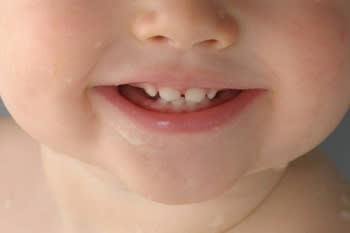Healthy smiles for kids

First smile, first tooth-some of the most anticipated kid "firsts" revolve around those pearly whites. Sadly, for many kids, the "first cavity" milestone is just around the corner. The odds a child age 2 - 11 has cavities in his or her primary (baby) teeth are 1 in 2.37. Those odds jump to 1 in 1.84 (54%) in families below the poverty line.
While oral health in the United States population overall has historically improved over time, the CDC reported that in young children, decay in primary teeth increased 17% from 1994 to 2004. And the recent recession has only made things worse. According to the Department of Health and Human Services, 26 million children are without dental insurance. And finding cash for preventative dental care has become a stretch for many parents-hence the projected 17 million children from low-income American families who go without dental care every year.
Cavities can start even before a child's first birthday, and the problem often worsens over time. More children age 6 - 11 and adolescents 12 - 19 suffer from tooth decay than from any other chronic disease. Dentists warn that tooth decay should be considered a gateway condition, because if left untreated its impact escalates over time. At the extreme, tooth decay has been linked to serious medical conditions, including diabetes, and even death from rare cases of rampant infection.
Many organizations are fighting to reverse the upsurge. The American Academy of Pediatric Dentistry (AAPD) recently began its "Get it Done in Year One" campaign, urging parents to schedule a dental visit in their child's first year and pointing out that early care can lead to 40% lower dental costs by the time a child is five. State governments are beginning to react too, with Massachusetts now mandating daily brushing and oral health education for all children who attend day care for more than four hours or eat a meal there.
Perhaps the biggest impact may come from the Children's Health Insurance Program Reauthorization Act of 2009 (CHIPRA). This law boosts dental coverage from an optional to a mandatory Medicaid benefit, and includes performance metrics that evaluate key prevention measures such as the application of dental sealants proven to reduce cavities. The hope is that with improved education, policy changes, and financial support, a kid's next big dental milestone-"first lost tooth"-will be a cause for celebration rather than dismay.
More from Book of Odds:
~~~
Posted By: Renata Pomponi
IStock Photo 164504 © Tomaz Levstek
